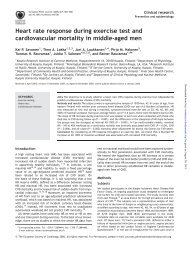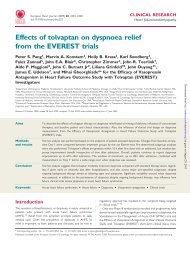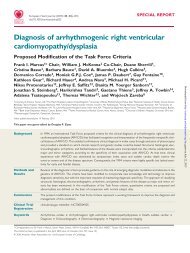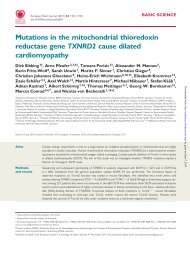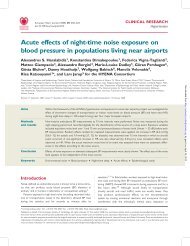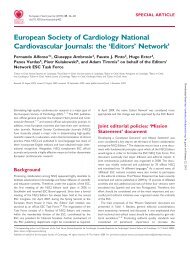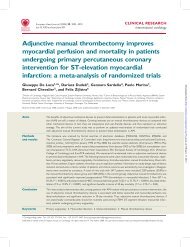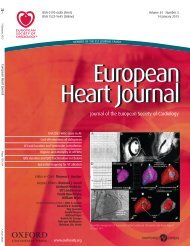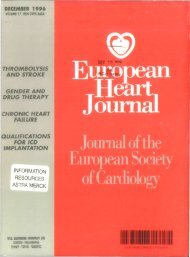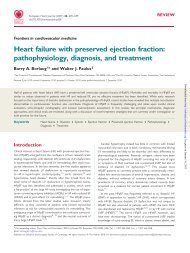Monday, 1 September 2008 - European Heart Journal
Monday, 1 September 2008 - European Heart Journal
Monday, 1 September 2008 - European Heart Journal
You also want an ePaper? Increase the reach of your titles
YUMPU automatically turns print PDFs into web optimized ePapers that Google loves.
288 Atrial fibrillation<br />
modelling characterised by interstitial fibrosis, atrial enlargement, slowed and<br />
heterogenous conduction, increased effective refractory periods and a greater<br />
propensity for AF. These findings highlight the importance of early and aggressive<br />
therapy for hypertension to prevent the development of arrhythmogenic substrates.<br />
P1902 Incidence of atrial fibrillation after percutaneous<br />
closure of patent foramen ovale and small atrial<br />
septal defects in patients presenting with cryptogenic<br />
stroke: a case-control study<br />
R. Bonvini, R. Sztajzel, M. Righini, P.A. Dorsaz, J. Alibegovic,<br />
C. Bonvin, U. Sigwart, E. Camenzind, V. Verin, J. Sztajzel on behalf of NA.<br />
University Hospital of Geneva, Cardiology, Geneva, Switzerland<br />
Background and Purpose: The occurrence of atrial fibrillation (AF) after percutaneous<br />
closure of a patent foramen ovale (PFO) for cryptogenic stroke has been<br />
reported in a variable percentage of patients. However, its precise incidence and<br />
mechanism are presently unclear and remain to be elucidated.<br />
Methods and Results: We started from 2002 onwards an arrhythmia follow-up<br />
(FU) protocol performing a 7-day event-loop-recording (ELR) at day 1, after 6 and<br />
12 months in patients who underwent a percutaneous PFO closure procedure for<br />
cryptogenic stroke. Ninety-two patients (Closure Group) were so far followed and<br />
then compared to a similar Control Group of 51 patients who did not undergo the<br />
PFO closure for several reasons. The incidence of AF was similar in both study<br />
groups during a FU of 12 months, including 7.6% (95% CI: 3.1%-15.0%) in the<br />
Closure Group and 7.8% (95% CI: 2.18%-18.9%) in the Control Group (p=1.0).<br />
The presence of a large PFO was the only significant risk factor for the occurrence<br />
of AF irrespective of the type of the administered treatment (i.e. interventional or<br />
medical). The odds ratio was 6.596 (95% CI, 1.660–26.21; P=0.0051).<br />
Conclusions: Patients with cryptogenic stroke and PFO had a rather high incidence<br />
of AF during a FU of 12 months, irrespective if the PFO was percutaneously<br />
closed or medically managed. The presence of a large PFO was the only<br />
significant predictor of AF occurrence during FU. Meticulous AF detection protocols<br />
should be performed in all cryptogenic stroke patients, especially in those<br />
scheduled for PFO-closure.<br />
P1903 Combined anatomical and electrogram-guided<br />
approach in catheter ablation of atrial fibrillation<br />
G.B. Nam, K.M. Park, K.J. Choi, Y.H. Kim. Asan Medical Center,<br />
Univ Ulsan Coll Med, Cardiology, Seoul, Korea, Republic of<br />
Purpose: Current catheter ablation of atrial fibrillation (AF) is focused<br />
on the elimination of pulmonary vein (PV) potentials. Tailored approach based on<br />
complex fractionated electrograms (CFE) has been proposed. Additive effect of<br />
this electrogram-guided approach in addition to the anatomical PV antral isolation<br />
has not been reported.<br />
Methods: 1. Patients with symptomatic, drug-refractory AF (paroxysmal, 76, persistent,<br />
29 pts) were included. 2. Catheter ablation was guided by fluoroscopy<br />
or 3D mapping system (NavX or CARTO). 3. PV antral isolation (PVAI) was<br />
performed targeting elimination or dissociation of PV potentials. After PVAI,<br />
electrogram-guided ablation was continued targeting CFEs or high-frequency activity<br />
relative to the surrounding areas. 4. End-point of the procedure was noninducibility<br />
of AF in pts with paroxysmal AF (PAF), termination into sinus rhythm<br />
in pts with persistent AF (PeAF).<br />
Results: 1. In PAF, PVAI alone rendered AF non-inducible in 42 of 79 pts (55%).<br />
After electrogram-guided ablation, AF became non-inducible in additional 12 pts<br />
(16%), while only atrial flutters (AFL) were induced in 16 pts (21%). AF persisted<br />
in 6 pts (8%) after this combined ablation procedure. In 16 pts with inducible<br />
AFL (27 AFLs), mechanisms of tachycardia included right isthmus dependent in<br />
5/27, perimitral in 4/27, roof-dependent in 4/27, focal in 8/27, and unknown in<br />
6/27 AFLs. 2. In PeAF, PVAI restored sinus rhythm in 0/29 pts. After electrogramguided<br />
ablation, AF converted directly into sinus rhythm in 2(7%) and into AFLs<br />
in 19 pts (65%), while AF persisted in 8 pts (28%). In 19 pts with AFLs (38 AFLs)<br />
converted from AF, mechanisms of tachycardia were right isthmus dependent in<br />
12/38, perimitral in 11/38, roof-dependent in 5/38, focal in 6/38, and unknown in<br />
4/38 AFLs.<br />
Conclusions: Electrogram-guided ablation targeting CFEs after PVAI resulted in<br />
non-inducibility of AF in pts with PAF, or conversion of AF into AFL in pts with<br />
PeAF. The major mechanism of the induced or converted AFLs during this combined<br />
procedure was macroreentry around the large anatomic obstacles such as<br />
tricuspid/mitral annulus or PVs.<br />
P1905 Anatomical differences in the coronary venous<br />
system in patients with persistent atrial fibrillation<br />
compared to patients in sinus rhythm<br />
E. Arbelo Lainez, E. Caballero Dorta, J. Novoa Medina, A. Garcia<br />
Quintana, A. Delgado Espinosa, C. Amador Gil, M.C. Rios Diaz,<br />
A. Medina Fernandez-Aceytuno. Hospital de Gran Canaria Dr. Negrin, Servicio<br />
de Cardiologia, Las Palmas De Gran Canaria, Spain<br />
Introduction and Objective: The coronary sinus (CS) muscle sleeves have been<br />
suggested to have role in the genesis of atrial fibrillation (AF), having been described<br />
a higher probability of conversion to sinus rhythm (SR) by ablating at that<br />
level in patients (p) with persistent AF. The aim was to describe the anatomy of<br />
the coronary venous system in p with persistent AF.<br />
Methods: The anatomy of the CS and its tributaries was studied by hyperemic<br />
coronary venous return angiography and/or occlusive retrograde senovenography<br />
in 319 p, 47 (15%) of which were in persistent AF (70% male, 64,8±10,5 years<br />
left atrial diameter 47,5±6,6 mm).<br />
Results: The diameter of the CS ostium was 17,3±5 mm with the presence of a<br />
Thebesian valve in 37 p (79%) that covered 45,9±33,8% of the orifice and left an<br />
opening into the right atrium of 12,1±6,3mm. The length of the CS was 42,3±12,8<br />
mm and its diameter 13,3±2,7 mm, whereas that of the great cardiac vein (GCV)<br />
was 10,7±2,7 mm. The oblique vein of Marshall was observed in 27 p (57%) and<br />
the Vieussens valve (ViV) in 33 (70%), being the two associated in 25 p (53%). In<br />
4 p an aneurismatic dilatation of the proximal CS (8,5%) was seen and in 32 (68%)<br />
diastolic compression of the CS was present, 12 of which (25,5%) consisted of<br />
a discrete muscular sleeve of 3 to 7 mm width. 4 p (8,5%) additionally showed<br />
muscular sleeves over the tributary veins of the CS. The mean diameter of the<br />
lateral vein was 4,2±1,4 mm. When comparing this group in persistent AF to the<br />
272 p in SR, statistically significant differences were found in terms of diameter<br />
of the CS ostium, the CS and GCV. The VoM were also more prevalent, with a<br />
greater length and diameter. Finally, the ViV and an aneurismatic dilatation of the<br />
proximal CS were also more frequent.<br />
Conclusions: The anatomy of the CS and its tributaries has differential characteristics<br />
in patients with persistent AF. This might play a role in the mechanisms<br />
of AF or have implications in the design of the ablation procedure.<br />
P1906 Time-dependent regional differences in sources of<br />
oxidative stress in atrial fibrillation-induced<br />
remodelling<br />
S.N. Reilly1 , U. Schotten2 ,N.J.Alp1 , B. Casadei1 . 1University of Oxford, Cardiovascular Medicine, Oxford, United Kingdom;<br />
2University of Maastricht, Physiology, Maastricht, Netherlands<br />
Purpose: Atrial fibrillation (AF) is associated with electrical and structural atrial<br />
remodelling and with increased myocardial oxidative stress, leading to reduced<br />
nitric oxide (NO) bioavailability and NOS uncoupling. To date, it is unclear whether<br />
oxidative stress is a trigger or a by-product of atrial remodeling. We evaluated the<br />
time course and sources of superoxide (O2-) production in the right (RA) and left<br />
(LA) atria of a goat model of pacing-induced AF.<br />
Methods: Atrial O2- was assessed (lucigenin-enhanced chemiluminescence and<br />
2-OH ethidium detection by HPLC) 14 days after the onset of AF (i.e. only electrical<br />
remodeling presents) and after 6 months (electrical and structural remodeling).<br />
The NOS cofactor BH4 and NOS activity were assessed by HPLC.<br />
Results: In early AF O2- release was significanty increased in the LA only (Figure,<br />
n=4). Inhibition of NADPH oxidases normalized O2- production in LA-AF but<br />
had no effect in the RA or in SR. Atrial NOS activity and nNOS protein expression<br />
but not BH4 level were reduced in both atria in AF.<br />
In late AF, O2- release was greater in both atria (Figure). NADPH oxidase inhibition<br />
did not affect O2- production, whereas inhibition of NOS or mitochondrial<br />
Abstract P1905 – Characteristics of the CS in AF and SR<br />
N Diameter Effective orifice Aneurismatic Diameter Diameter Presence of Diameter Presence of<br />
of the CS ostium (mm) of the CS (mm) proximal CS (%) of the CS (mm) of the GCV (mm) VoM (%) of VoM (mm) ViV (%)<br />
AF 47 17,3±5 12,1±6,3 8,5% 13,3±2,7 10,7±2,7 61% 2,04±0,7 75%<br />
SR 272 13,4±4,4 8,9±4,1 2% 10,6±2,8 9,1±2,2 36% 1,6±0,8 57%<br />
p



